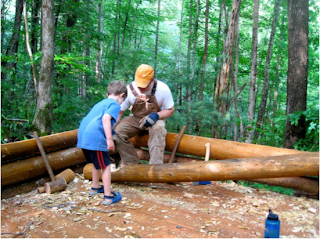Last Thursday, my dad came up to spend the evening with us. On Tuesday, Tobias had dropped and bucked five trees, and I was anxious to strip the bark before they dried -- when fresh and wet, it comes off in long, curved swaths, lubricated by slick moisture trapped between the cambrium and the woody trunk.
So dad, feeling better but still recovering from back surgery, and Abel, full of energy but only five-years-old, accompanied me to where the logs lay. Dad sat on a stump and watched; to Abel, I gave a "tool" to work on his own log while I got into action with the sharp bark spud. I think it was a large c-clamp. I should have been ashamed; I grabbed it because it was handy, safe, and enigmatic enough that he'd be tricked.
Soon, I had massive pieces of bark on the ground and lots of pretty, newly exposed wood -- straight poplar, once stripped, looks clean and slightly dimpled, almost as if it's been whittled smooth by a giant with jackknife. I felt industrious, manly, competent. Impressed with myself, and my cool tool. Then, I looked up.
Abel stood over my work. Useless c-clamp clenched. Fighting tears. Behind us, nicked but intact logs lay, picked at by an inadequate tool held by an eager but naive small boy. "Daddy, I... I. I want to hayulp." Ending on a down note. More tears, and he managed somehow to look smaller than he is.
"Abel, use your tool."
"No dad, it doesn't work. I want to use
that tool," he said, pointing at the bark spud I held in my hand. You gotta hand it to a small child, certain that it was the tool that made all the difference, willing to believe that with the right tool, he can do anything, despite the limits of his own skills, experience, or strength. We're like that as adults, too, and as a society. The right tools or technology can arrest oil spills, put men on the moon, put any kind of information at our fingertips. Tools can do anything. Jiminy Cricket! Eureka! I'm not so sure, but I wouldn't want to squelch his enthusiasm or his sweet belief that anything is possible. In this case, he was right.
I feel pressure to debark all these logs, to stay on my time line, to send him away, to distract him somehow. But this interruption needs to be accepted, unlike some of the times my wife calls or rings the bell (yes, we have a bell, and that's another story). The logs don't matter. Also, my Dad watches. Somehow his silence seems like some kind of confidence, in me, that I should pass along to my own son. "Abel, do you think you can hold this tool, like this?" He nods. "Can I hold it too, maybe right here?"
"OK Dad, but let
me do it." Move the tool. With less guidance than I expected, he slides it under the bark, only letting me get it started. This bark spud really is magical; combined with the properties of fresh poplar that I described, it removes bark with little effort. We work. He laughs. Bark gets pried loose, then we drop the tool, I hand the end of a piece of bark to him, I help, and we pull it off in a really long strip. Soon, we're smoking. On a roll. Before I know it, we've debarked a whole log, fourteen feet, more than I would have ever expected given a child's propensity for distraction and Abel's age-specific attention span. "Dad, let's do another!"
Beginning our second log, Abel is really getting the hang of the tool -- I'm holding on more just to prevent an accident than to assist him. The bark spud has a long, spoon-like curved blade, except unlike a spoon it's flat across the width, not concave. This curvature slides under the bark and along the roundness of the tree trunk, from side-to-side. It also has rounded, sharp corners transitioning from the flat head of the blade to the sides, which are also sharp. Getting under the bark requires digging these corners in between it and the wood and gently rocking the tool until it slips into that space. Apparently, Abel had watched me do this, and without direction, he applied the technique, along with an original (not from my lips), metaphoric declaration: "Dad, you've gotta walk the baby. Look Dad, walkin' the baby!" and he "walked" the tool back and forth, back and forth, until it did its job. To the rhythm of the Saturday Night Live skit that he'd never even heard, "Makin' copies," we were "Walkin' the baby..."
After two logs, Abel asked if he could go back to the house and get a popsicle. "Sure son -- I'm proud of you. You did a great job."
"You did a great job too, Dad. Bye!" I hope so, because he sure did.



 "UUUNNNGH! If I had pants, I could do it for sure."
"UUUNNNGH! If I had pants, I could do it for sure."











 Here's three of the nine logs we reaped from Tobias's five tree harvest:
Here's three of the nine logs we reaped from Tobias's five tree harvest: